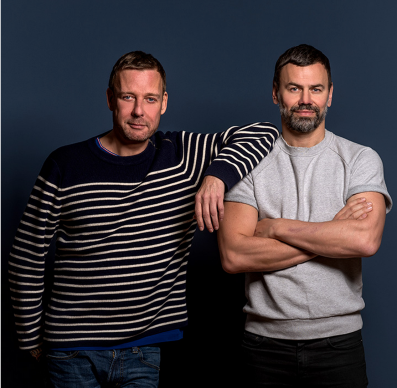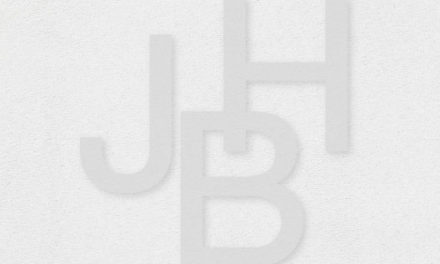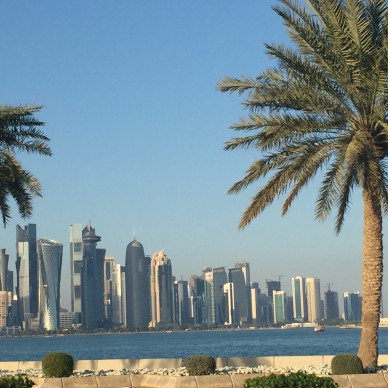Gagosian Le Bourget
It’s probably the biggest aesthetic show of emotion in France right now. At Gagosian’s space located in Le Bourget, at the heart of the air terminal complex for private jets, which is accessible from Tuesday to Sunday, the gallery is presenting new work from the German painter Anselm Kiefer (born in 1945).
Worth the trip
The show is worth the trip, especially during these times of artistic scarcity. It’s the perfect illustration of the power of art in troubled times. The artworks provoke a visceral reaction.
Cerebral painter
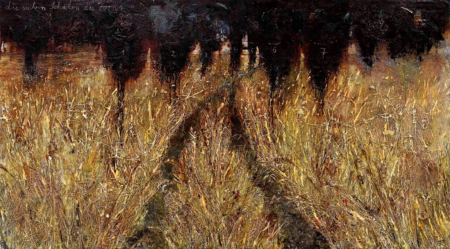
Imagine a huge concrete room – the site was designed by Jean Nouvel – with only four canvases. Each one measures 8.4 metres long by 4.7 metres tall and initially gives the sense of a landscape. Anselm Kiefer is a very cerebral and erudite painter who talks about philosophy, poetry, kabbalah, historic events… But what matters here is how the viewer feels in the presence of this spectacle. People may be familiar with his work thanks to his retrospective at the Centre Pompidou in 2015, among other shows.
Witnessing a renaissance
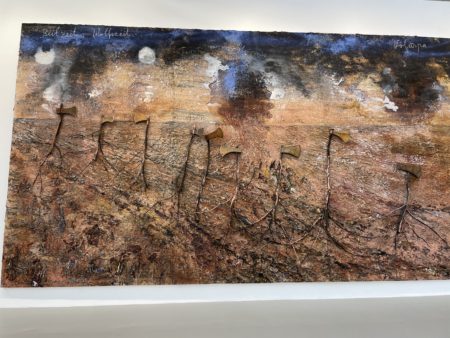
But we must acknowledge that with this new series we are witnessing a renaissance. His paintings are denser and more luminous: more powerful. In the interview that I conducted with him over zoom – it was the first time he has accepted to do this kind of interview – he said he hasn’t noticed any change, but he is happy that I have. Nor is he aware of the new density of the paint in his new work.
Painting is a drama
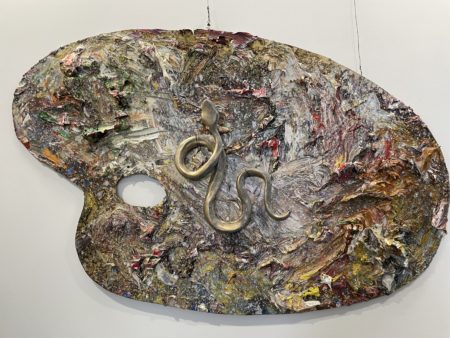
“Doing painting is a drama. First a fight in the head. A painter has a duty to be iconoclastic. I am very physical. I’m a dancer you know,” he says. In fact Kiefer has a reputation for being quite grouchy and reticent in the face of questions. And here he is now, smiling and open as though his life has undergone a fundamental change, which is having a strong impact on his work.
Axes and scythes
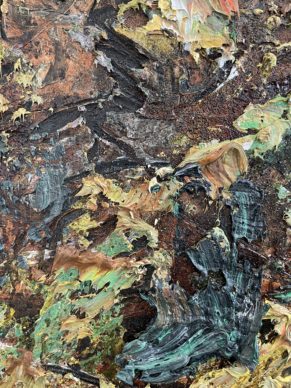
When the viewer is up close to the canvas, the countless thick brushstrokes are reminiscent of Van Gogh’s technique and that of the post-impressionists mixing various textures: blades of wheat, all kinds of grasses, dust, etc. When we step back, it’s the colourful atmosphere and luminous power that are brought to the fore instead, while real-life objects (axes, scythes) draw the attention secondarily. They are literally planted amid the thick polychrome.
Splendour and peace

Then there’s time for explanations. The title of the exhibition, “Field of the Cloth of Gold “refers to a diplomatic encounter in 1520 between Francis I of France and Henry VIII of England, near Calais. In the middle of the countryside, the two monarchs convened to outdo one another in splendour in a bid for peace. This most likely was the origin of Kiefer’s bursts of gold paint in contrast with black and dark blue, like in the paintings of Paolo Uccello in the 15th century.
Europe
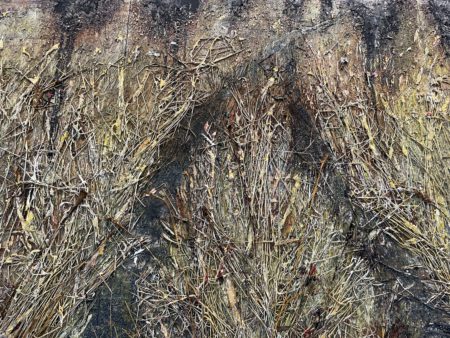
The pandemic has been an opportunity for Kiefer to isolate himself even more than usual. This hasn’t hindered him much, on the contrary it has allowed him to concentrate better. Yet in political terms, he is anxious about Europe’s position in the great game of nations. “As a European, I think we are going through a difficult period, caught between the two giants of China and America. Europe must become a mature political entity, which is what Francis I wanted.”
Artistic memoir
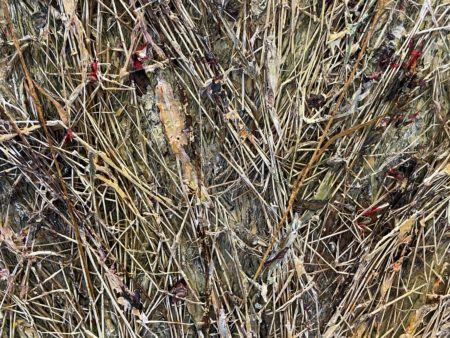
The painter informs us that every morning he writes in his journal, which is a kind of memoir of his artistic preoccupations. He reads, too. He refers to Kundera’s “Unbearable Lightness of Being”, Musil’s “Man Without Qualities” and Shakespeare’s Macbeth, one of whose characters could well be a future source of inspiration.
From hearts and brains
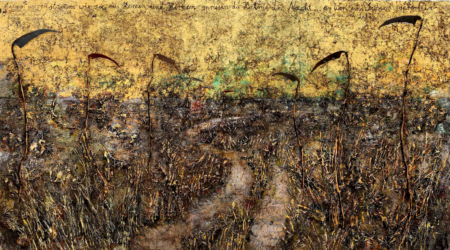
The most fascinating of the paintings from the exhibition at Le Bourget takes its title from a work by the Romanian poet Paul Celan, “From Hearts and Brains the Stalks of Night Are Sprouting”. Here it’s the scythes of death that loom ominously in the middle of a raked field of wheat.
Kiefer creates images that are all about textures, which are able to embrace the bleakness of the present day.
Until 28 March. Le Bourget.
https://gagosian.com/exhibitions/2021/anselm-kiefer-field-of-the-cloth-of-gold/
7 other canvases and a series of giant books are also on display at Gagosian’s space at Le Bourget.
Anselm Kiefer at Le Panthéon
Emmanuel Macron
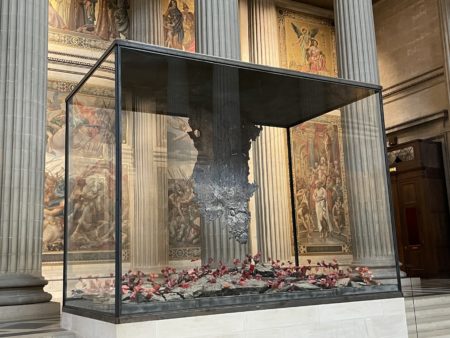
It was President Emmanuel Macron who, through personal and unilateral choice – which is relatively rare, despite there being some precedents such as François Mitterrand – decided to ask the German artist who is based in France, to contribute a permanent installation to the monument dedicated to the great figures of the French republic, the Panthéon. Discussions between the president, the artist and the authorities who run the site began on 6 January 2020 and the installation opened on 11 November 2020 to mark the induction of the writer Maurice Genevoix into the Panthéon.
A gift to France
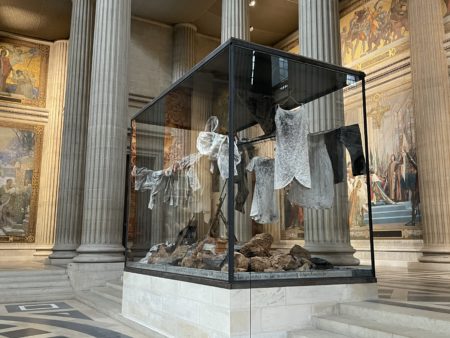
He is the author of “Ceux de 14” (The Men of 14), a collection of memoirs from the First World War that Kiefer illustrates through six monumental spectacular vitrines, which – it is worth highlighting – the artist gifted for the occasion. These evocations of death, fire, disappearance, memory, destruction and desolation… are accompanied by excerpts from Genevoix’s text. One of these is: “And the good earth of France swiftly hides from sight those greenish uniforms, those decomposing faces with blinded eyes, those heavy nailed boots which never again will trample the soil of our beloved land.”
The women of 14
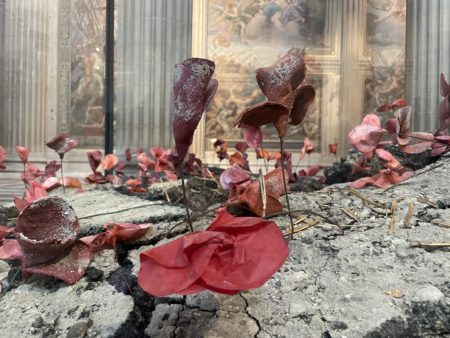
In one of the vitrines there is an inscription in chalk on a metal plaque alongside “Ceux de 14”, to the “Celles de 14” (The Women of 14) which highlights the war effort among women, of which the 21st century is more aware.
Oversized canvases
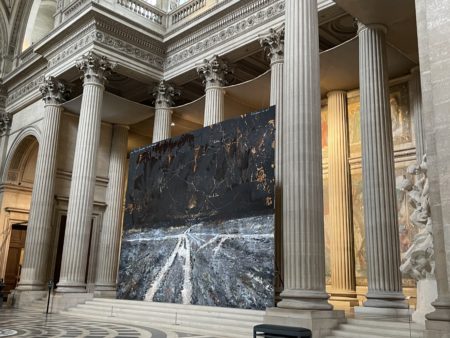
At the entrance to the old church converted into a memorial site in 1885, Kiefer has temporarily placed two extremely oversized canvases (710x950cm), landscapes of death, which are also linked to Genevoix’s writings. The ensemble is accompanied by a sound installation by Pascal Dusapin which is emitted periodically.
The symbol
There have been no commissions for the Panthéon since 1925. The choice of a German artist to commemorate the World War I Armistice is strongly symbolic. Up until now no one has seen Kiefer’s works at the Panthéon except for guests from the Elysée. We will have to wait for the reopening of French museums for that. Then the two paintings will remain in situ for one month before returning to the artist’s huge studios in the Parisian region, in Croissy.
Sur les places de nos villages, à l’Arc de Triomphe, nous ne cessons de les honorer depuis un siècle. Au Panthéon aussi désormais, et à travers les œuvres d’Anselm Kiefer et de Pascal Dusapin. Maurice Genevoix et Ceux de 14 sont là. Pour toujours. pic.twitter.com/DEilOoUnUd
— Emmanuel Macron (@EmmanuelMacron) November 14, 2020
Donating=Supporting

Support independent news on art.
Your contribution : Make a monthly commitment to support JB Reports or a one off contribution as and when you feel like it. Choose the option that suits you best.
Need to cancel a recurring donation? Please go here.
The donation is considered to be a subscription for a fee set by the donor and for a duration also set by the donor.

